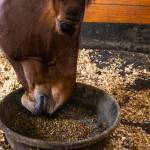High-Tech Detection of Hindgut Acidosis in Horses

If the intricacies of the equine gastrointestinal tract interest you, you know well the delicacy of the hindgut. In the best of times, the resident microbes ferment forages continuously, creating energy for the horse. If certain bacteria become dominant in the microbiome, especially those that produce lactic acid, the pH drops, leading to a condition called hindgut acidosis. At its least harmful, hindgut acidosis causes a decrease in forage utilization, changes in body condition and behavior, and discomfort. At its most insidious, hindgut acidosis may contribute to colic or laminitis. Detecting hindgut acidosis remains an inexact science, but scientists are looking closely at the population of specific microbes in the hindgut as a way to gauge acidosis.
In a recent study, researchers at Bangor University in Wales zeroed in on two bacteria, Streptococcus equinus and Mitsuokella jalaludinii. Both produce high levels of lactic acid in the hindgut after a meal rich in nonstructural carbohydrates. Increased presence of these bacteria could predict acidosis in susceptible horses, researchers theorized, allowing owners to change management strategies to recalibrate the hindgut. In crafting a practical testing technique, researchers focused on a rapid, highly specific method to detect the two bacteria and transportability so it can be used stall-side.
Scientists looked to biosensors as a potential diagnostic device, as they have the ability to quickly and inexpensively detect the bacteria. They tested four variations, all of which were designed to detect DNA of the target bacteria Streptococcus equinus and Mitsuokella jalaludinii. In the end, only one of the variations identified the bacteria.
According to the researchers, the “proposed electrochemical biosensor could be used for equine acidosis monitoring and detection to help prevent laminitis,” though more work is necessary before it is available as a point-of-care diagnostic test.
“It only takes a matter of hours after a meal rich in nonstructural carbohydrates for these lactic acid-producing bacteria to substantially increase in numbers, making them valuable measurements,” said Kathleen Crandell, Ph.D., a nutritionist with Kentucky Equine Research. “These researchers see the value in perfecting a tool to use on-site to identify a bloom of these bacteria in the hindgut. Dietary adjustments then can be made to head off hindgut acidosis and subsequent colic or laminitis before they take hold.”
Hindgut acidosis remains an important cause of gastrointestinal distress in many horses. While researchers perfect detection methods, what can be done for these horses? Prevention of hindgut acidosis may require a shift in management strategies so that large amounts of starch do not enter the cecum and colon. Instead of feeding two large meals a day, for example, feed three or four. While the amount of concentrate fed per day does not change, it is divided into smaller meals, which allows the small intestine to handle the meals more efficiently with less likelihood that excessive starch will pass to the hindgut.
While changes in management can help some horses with hindgut acidosis, many horses benefit from EquiShure, a research-proven hindgut buffer. EquiShure features encapsulation technology that ensures targeted release of the buffering agent directly into the hindgut.
*Davies, J., C. Thomas, M. Rizwan, and C. Gwenin. 2021. Development of electrochemical DNA biosensor for equine hindgut acidosis detection. Sensors 21:2319.








